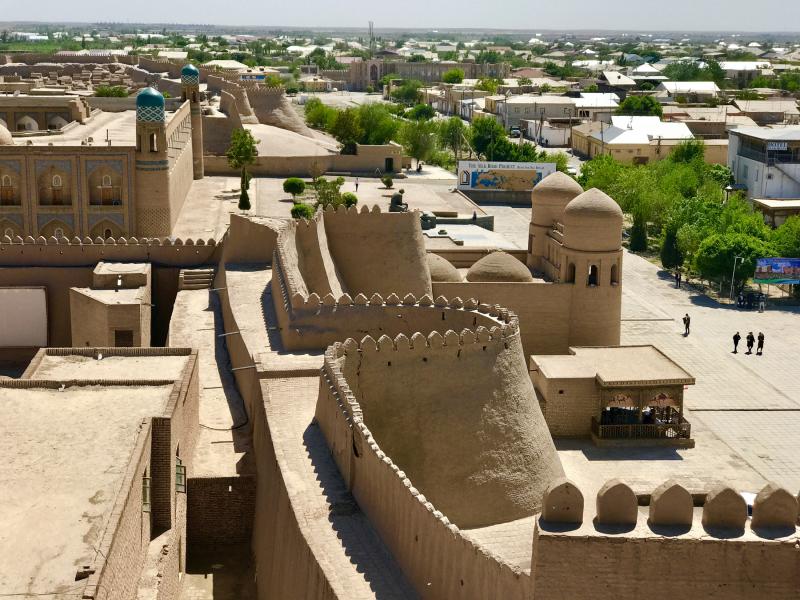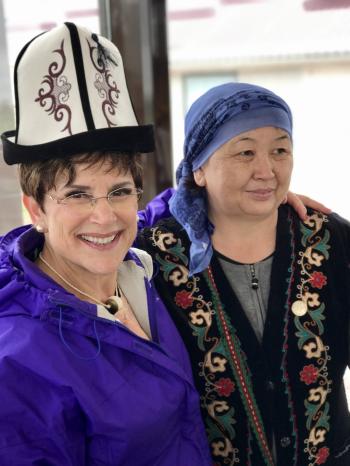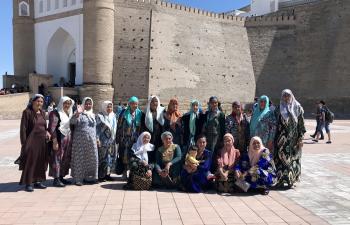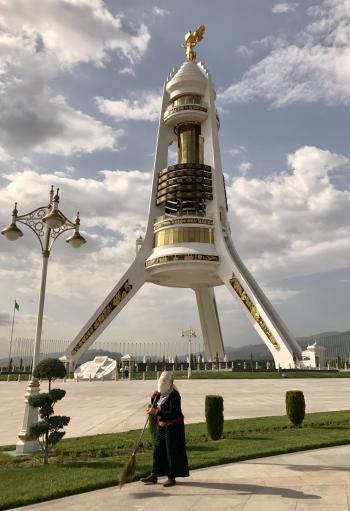Feeling truly welcomed on a visit to the Five ‘Stans
This article appears on page 42 of the June 2018 issue.
If I die with any money in the bank, there was one trip I forgot to take.
In an effort to live up to this mantra, I embarked in April 2017 on an exotic adventure offered by JMG Tibet Tours (Lauderhill, FL; 866/548-4238, www.jmgtibettours.com) along the ancient Silk Road that ran through the now-independent republics of Kazakhstan, Kyrgyzstan, Uzbekistan, Tajikistan and Turkmenistan ($6,295 per person, double, for the 28-day tour).
When friends heard of my plans, the unanimous response was “Why?” Everyone tried to impart fear and uncertainty into my consciousness. With trepidation, I awoke in Astana, Kazakhstan, seemingly a hodgepodge of a capital city — with architecturally diverse and unique, modern structures and colored lights at night.
Welcome to Central Asia!
A fine beginning
Serendipitously, the 16 travelers in our group discovered a welcoming synagogue in Astana and were enveloped by the warm embrace of two rabbinical students doing outreach in Kazakhstan. They translated the Passover service into English for us, illustrated by colorful, comprehensive Haggadah prayer books. With very little common language, friends were made, bread was broken, and the evening was magical.
As I ventured to a local store on my own, I tried to communicate “vodka and orange juice” to everyone in the market. Several workers gathered ’round, traveling with me around the store as I tried to convey the products desired. (Try demonstrating an orange!)
No one spoke a word of English nor seemingly comprehended, but I finally left the store with some semblance of the ingredients of a screwdriver. Everyone was smiling.
Americans are unique in Central Asia. Outside of our tour, I saw nary a one for seven weeks.
As our group of adventurers traversed the five ’Stans, the regionally distinctive, colorful patterns of dress and hats we saw were breathtaking. To combat the monotony of the desert sands, the fabrics are brilliantly colored with cacophonous stripes and mismatched patterns that light up the monochromatic surroundings.
The rugged natural landscape was diverse, from temperate, grassy steppes and undulating valleys to unrelentingly windy, blazing-hot deserts dotted with freely roaming Uzbek camels and their hook-carrying shepherds. Each day began as a blank template to be filled with unexpected adventures.
Interesting encounters
In Karakol, Kyrgyzstan, our adorable, youthful local guide, Ramil, was amused as a gaggle of giggling Kyrgyzstani women stared, pointing and whispering, before they eventually asked me, “Are you an American?” When I shook my head to the affirmative and said, “I’m from the United States,” their faces broke into wide, gold-toothed smiles, their thumbs pointing upward for emphasis.
Although the pervading feeling in Kyrgyzstan’s capital city, Bishkek, was one of militaristic control, I found the people to be so warm, friendly, curious and open, with unabashed enthusiasm.
I also felt welcomed on our hike to the top of Sulaiman-Too Sacred Mountain, near the city of Osh, Kyrgyzstan. While we walked through lush, flaming-red poppy fields, our interactions with smiling, open-armed pilgrims on their sacred pilgrimages touched my heart.
In Istaravshan, a city in Sughd Province, Tajikistan, a group of well-behaved schoolchildren were out on a clean-the-sacred-area-around-the-walled-city field trip. As usual, our group was a unique oddity to these locals. We were surrounded, with everyone wanting us to take his or her picture while hugging or high-fiving us. The genuinely excited youngsters didn’t want us to leave!
Wherever we traveled, college-age youths would follow us, displaying a friendly openness, curiosity and persistence about wanting to talk to or “interview” us. They would stare, giggle, point and then push each other forward. They were desperate to practice their English.
Into Uzbekistan
Crossing the tiny Uzbekistan border, again on foot, I was fearful that some of us wouldn’t pass the intrusive examination of each item in our belongings. Seeking “mind-altering” drugs, including sleeping pills, the guards were thorough.
When the guard held up my Passover souvenir box of matzohs from Kazakhstan, she curiously queried “What is this?” in hesitating English. My mind racing through everything I had been warned about — the Uzbeks do not want religious items imported — I rapidly explained that the “crackers” increased body strength and vitamins. Without hesitation, the guard removed the giant matzoh from the box, smiled, peered at it and then broke off a huge hunk and ate it!
Driving from Samarkand, Uzbekistan, to Bukhara was an all all-day trip over a route dotted with caravanserais, the precursor of today’s truck stops. A network of these caravanserais was set up along the major trade routes that connected Asia, North Africa and Southeastern Europe with the distance of a day’s travel between them.
This reminded me of Franciscan friar Junípero Serra, who created the first nine of California’s 21 Spanish missions, each situated one day’s horseback ride from the next. The caravanserais were created with the same sort of functionality, providing a place where the camels could rest and be fed and people could bathe, eat and rest overnight.
Visiting the Silk Road is a journey back in time. The markings that could be seen on the ground at Khiva, Uzbekistan, were made by carts hundreds of years ago. The feelings that pervaded my consciousness were overwhelming.
I was able to bake Uzbek bread, kneading the dough, stamping it in the center with decorative stamps and then, with arms covered in elbow-to-fingertip gloves, slapping it onto the sides of a flaming, beehive-shaped clay oven without even scorching the hair on my arm.
Turkmenistan
As we moved into Daşoguz, Turkmenistan, crossing yet another border on foot, we were immediately impressed with the sea of “uniformity” of the young people’s clothes. Moving through the streets as a tightly knit clique, adolescent girls wore long, silky green dresses adorned with varying embroidered Turkmen designs on the front, with waist-long braids draped in front of them.
Older girls, who had matriculated into high school, still meandered together, but their outfits changed from green to shiny red.
When the young women marry, the braids disappear to be replaced by unusually elevated headdresses (boosted by foam forms), a symbol of beauty, status and wealth.
As our group entered the awe-inspiring all-white-marble capital of Ashgabat, Turkmenistan, our mouths agape, we observed out-of-this-world structures, each more unusual than the next. Every surface of the city seemed to be covered in white marble, and there was not a single soul on the streets except for the ubiquitous street sweepers.
From Ashgabat, we flew to the ancient city of Merv, a UNESCO World Heritage Site. As we were walking out of the Sultan Sanjar’s mausoleum there, a group of Turkmen women walked over to me and looked me in the face, then one of the women grabbed me with such force and started hugging me, while the rest of the gold-toothed women in her group smiled broadly. It was so spontaneous and unexpected, and I was touched by the joyousness of the moment.
Final reflections
One of our last forays into the ancient past was at the Parthian Fortresses of Nisa, one of the most important cities of the Parthian Empire, a major power from the mid-3rd century BC to the 3rd century AD.
As we were exploring the recent excavations there, we happened upon a Turkmen singing-star’s photo shoot. The hospitable singer was wearing a brilliantly adorned traditional costume (that weighed a ton), and she graciously posed for us, swirling around with the archaeological site as her backdrop. This was one of those moments that make travel so inspiring.
Our group of 16 intrepid travelers, now good friends, dressed in traditional outfits and enjoyed a farewell dinner before our sweet parting at the Ashgabat International Airport.
As French novelist Gustave Flaubert mused, “Travel makes one modest; you see what a tiny place you occupy in the world.”




